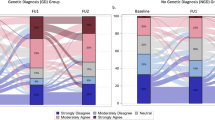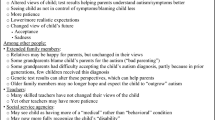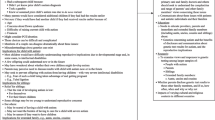Abstract
Genetic research in autism depends on the willingness of individuals with autism to participate; thus, there is a duty to assess participants’ needs in the research process. We report on families’ motives and expectations related to their participation in autism genetic research. Respondents valued having a genetic result, as it alleviates guilt, promotes awareness, and may be used to tailor interventions and for family planning. The act of participating was distinctly significant, as it provided personal control, a connection to autism experts, networking with families, and hope for the future. The results of this study highlight complex factors involved in families’ decisions to participate in autism genetic research and provide points to consider for this population of research participants.
Similar content being viewed by others
References
Abelson, J., Miller, F. A., & Giacomini, M. (2009). What does it mean to trust a health care system? A qualitative study of Canadian health care values. Health Policy, 91(1), 60–63.
Bailey, A., LeCouteur, A., Gottesman, I., Bolton, P., Siminoff, E., Yuzda, E., et al. (1995). Autism as a strongly genetic disorder: Evidence from a British twin study. Psychological Medicine, 25(1), 63–77.
Baret, L., & Godard, B. (2011). Opinions and intentions of parents of an autistic child toward genetic results: Two typical profiles. European Journal of Human Genetics, 19(11), 1127–1132.
Berkenstadt, M., Shiloh, S., Barkai, G., Katznelson, M. B., & Goldman, B. (1999). Perceived personal control (PPC): A new concept in measuring outcome of genetic counseling. American Journal of Medical Genetics, 82(1), 53–59.
Bouma, R., & Schweitzer, R. (1990). The impact of chronic childhood illness on family stress: A comparison between autism and cystic fibrosis. Journal of Clinical Psychology, 46(6), 722–730.
Canvin, K., & Jacoby, A. (2006). Duty, desire or indifference? A qualitative study of patient decisions about recruitment to an epilepsy treatment trial. Trials, 12(7), 19–32.
Charmaz, K. (2000). Grounded theory objectives and constructive methods (2nd ed., pp. 509–535). Thousand Oaks, CA: Sage.
Codori, A. M., Waldeck, T., Petersen, G. M., Miglioretti, D., Trimbath, J. D., & Tillery, M. A. (2005). Genetic counseling outcomes: Perceived risk and distress after counseling for hereditary colorectal cancer. Journal of Genetic Counseling, 14(2), 119–132.
Cook, E. H., Jr., & Scherer, S. W. (2008). Copy-number variations associated with neuropsychiatric conditions. Nature, 455(7215), 919–923.
Croyle, R. T., Dutson, D. S., Tran, V. T., & Sun, Y. C. (1995). Need for certainty and interest in genetic testing. Women’s Health, 1(4), 329–339.
Folstein, S., & Rutter, M. (1977). Genetic influences and infantile autism. Nature, 265(5596), 726–728.
Fombonne, E. (2005). Epidemiological studies of autism and pervasive developmental disorders. In F. Volkmar (Ed.), Handbook of autism and pervasive developmental disorders (3rd ed., pp. 42–69). New York: Wiley.
Geller, G., Tambor, E. S., Chase, G. A., & Holtzman, N. A. (1993). Measuring physicians’ tolerance for ambiguity and its relationship to their reported practices regarding genetic testing. Medical Care, 31(11), 989–1001.
Guest, G., Bunce, A., & Johnson, L. (2006). How many interviews are enough? An experiment with data saturation and variability. Field Methods, 18(1), 59–82.
Hallowell, N., Cooke, S., Crawford, G., Lucassen, A., Parker, M., & Snowdon, C. (2010). An investigation of patients’ motivations for their participation in genetics-related research. Journal of Medical Ethics, 36(1), 37–45.
Hayeems, R. Z., Miller, F. A., Li, L., & Bytautas, J. P. (2011). Not so simple: A quasi-experimental study of how researchers adjudicate genetic research results. European Journal of Human Genetics, 19(7), 1–8.
Lipinski, S. E., Lipinski, M. J., Biesecker, L. G., & Biesecker, B. B. (2006). Uncertainty and perceived personal control among parents of children with rare chromosome conditions: The role of genetic counseling. American Journal of Medical Genetics, 142C(4), 232–240.
MacLeod, R., Craufurd, D., & Booth, K. (2003). Patients’ perceptions of what makes genetic counseling effective: An interpretative phenomenological analysis. Journal of Health Psychology, 7(2), 145–156.
Madsen, S. M., Mirza, M. R., Holm, S., Hilsted, K. L., Kampmann, K., & Riis, P. (2002). Attitudes towards clinical research amongst participants and nonparticipants. Journal of Internal Medicine, 251(2), 156–168.
Marshall, C. R., Noor, A., Vincent, J. B., Lionel, A. C., Feuk, L., Skaug, J., et al. (2008). Structural variation of chromosomes in autism spectrum disorder. American Journal of Human Genetics, 82(2), 477–488.
McAllister, M., Wood, A. M., Dunn, G., Shiloh, S., & Todd, C. (2011). The perceived personal control (PPC) questionnaire: Reliability and validity in a sample from the United Kingdom. American Journal of Medical Genetics, 158A(2), 367–372.
Meiser, B., & Dunn, S. (2001). Psychological effect of genetic testing for Huntington’s disease: An update of the literature. Western Journal of Medicine, 174(5), 336–340.
Meiser, B., Mitchell, P. B., McGirr, H., Van Herten, M., & Schofield, P. R. (2005). Implications of genetic risk information in families with a high density of bipolar disorder: An exploratory study. Social Science and Medicine, 60(1), 109–118.
Meulenkamp, T. M., Gevers, S. K., Bovenberg, J. A., Koppelman, G. H., van Hylckama Vlieg, A., & Smets, E. M. (2010). Communication of biobanks’ research results: What do (potential) participants want? American Journal of Medical Genetics, 152A(10), 2482–2492.
Miller, F. A., Giacomini, M., Ahern, C., Roberts, J. S., & de Laat, S. (2008). When research seems like clinical care: A qualitative study of the communication of individual cancer genetic research results. BMC Medical Ethics, 9(4), 1–12.
Miller, D. T., Adam, M. P., Aradhya, S., Biesecker, L. G., Brothman, A. R., Carter, N. P., et al. (2010a). Consensus statement: Chromosomal microarray is a first-tier clinical diagnostic test for individuals with developmental disabilities or congenital anomalies. American Journal of Medical Genetics, 86(5), 749–764.
Miller, F. A., Hayeems, R. Z., & Bytautas, J. P. (2010b). What is a meaningful result? Disclosing the results of genomic research in autism to research participants. European Journal of Human Genetics, 18(8), 867–871.
Miller, F. A., Hayeems, R. Z., & Bytautas, J. P. (2012a). What does ‘respect for persons’ require? Attitudes and reported practices of genetics researchers in informing research participants about research. Journal of Medical Ethics, 38(1), 48–52.
Miller, F. A., Hayeems, R. Z., Li, L., & Bytautas, J. P. (2012b). One thing leads to another: The cascade of obligations when researchers report genetic research results to study participants. European Journal of Human Genetics, 18(8), 867–871.
Ozonoff, S., Young, G. S., Carter, A., Messinger, D., Yirmiya, N., Zwaigenbaum, L., et al. (2011). Recurrence risk for autism spectrum disorders: A baby sibling’s research consortium study. Pediatrics, 128(3), e488–e495.
Patton, M. Q. (2002). Qualitative research and evaluation methods (3rd ed.). Thousand Oaks/London/Delhi: Sage.
Pinto, D., Pagnamenta, A. T., Klei, L., Anney, R., Merico, D., Regan, R., et al. (2010). Functional impact of global rare copy number variation in autism spectrum disorders. Nature, 466(7304), 368–372.
Quillin, J. M., Silberg, J., Jones, R. M., Wilson, D. B., Maes, H., Bowen, D., et al. (2008). Tolerance for ambiguity could influence awareness of breast cancer genetic testing and inform health education. Cancer Causes and Control, 19(10), 1227–1232.
Richards, M. P., Ponder, M., Pharoah, P., Everest, S., & Mackay, J. (2003). Issues of consent and feedback in a genetic epidemiological study of women with breast cancer. Journal of Medical Ethics, 29(2), 93–96.
Ritvo, E. R., Jorde, L. B., Mason-Brothers, A., Freeman, B. J., Pingree, C., Jones, M. B., et al. (1989). The UCLA-University of Utah epidemiologic survey of autism: Recurrence risk estimates and genetic counseling. American Journal of Psychiatry, 146(8), 1032–1036.
Sanders, J., & Morgan, S. (1997). Family stress and adjustment as perceived by parents of children with autism or Down syndrome: Implications for interventions. Child & Family Behavior Therapy, 19(4), 15–32.
Scherer, S. W., & Dawson, G. (2011). Risk factors for autism: Translating genomic discoveries into diagnostics. Human Genetics, 130(1), 123–148.
Sebat, J., Lakshmi, B., Malhotra, D., Troge, J., Lese-Martin, C., Walsh, T., et al. (2007). Strong association of de novo copy number mutations with autism. Science, 316(5823), 445–449.
Shen, Y., Dies, K. A., Holm, I. A., Bridgemohan, C., Sobeih, M. M., Caronna, E. B., et al. (2010). Clinical genetic testing for patients with autism spectrum disorders. Pediatrics, 125(4), 727–735.
Simons Foundation. (2010). Simons VIP connect: Simons variation in individuals project (VIP). Copyright, Simons Foundation, 2010. http://www.simonsvipconnect.org/. Accessed March 16, 2012.
Slevin, M., Mossman, J., Bowling, A., Leonard, R., Steward, W., Harper, P., et al. (1995). Volunteers or victims: Patients’ views of randomised cancer clinical trials. British Journal of Cancer, 71(6), 1270–1274.
State, M. W., & Levitt, P. (2011). The conundrums of understanding genetic risks for autism spectrum disorders. Nature Neuroscience, 14(12), 1499–1506.
Stolt, G. U., Liss, P. E., Svensson, T., & Ludvigsson, J. (2002). Attitudes to bioethical issues: A case study of a screening project. Social Science and Medicine, 54(9), 1333–1344.
Szatmari, P., Paterson, A. D., Zwaigenbaum, L., Roberts, W., Brian, J., Liu, X., et al. (2007). Mapping autism risk loci using genetic linkage and chromosomal rearrangements. Nature Genetics, 39(3), 319–328.
Tabor, H., & Cho, M. (2007). Ethical implications of array comparative genomic hybridization in complex phenotypes: Points to consider in research. Genetics in Medicine, 9(9), 626–631.
Tambor, E. S., Bernhardt, B. A., Chase, G. A., Faden, R. R., Geller, G., Hofman, K. J., et al. (1994). Offering cystic fibrosis carrier screening to an HMP population: Factors associated with utilization. American Journal of Human Genetics, 55(4), 626–637.
Treloar, S. A., Morley, K. I., Taylor, S. D., & Hall, W. D. (2007). Why do they do it? A pilot study towards understanding participant motivation and experience in a large genetic epidemiological study of endometriosis. Community Genetics, 10(2), 60–71.
Walsh, P., Elsabbagh, M., Bolton, P., & Singh, I. (2011). In search of biomarkers for autism: Scientific, social and ethical challenges. Nature Reviews, 12(10), 603–612.
Webb, S. (2010). Drugmakers dance with autism. Nature Biotechnology, 28(8), 772–774.
Weiss, M. (2002). Hardiness and social support as predictors of stress in mothers of typical children, children with autism, and children with mental retardation. Autism, 6(1), 115–130.
Acknowledgments
Magan Trottier would like to acknowledge the support and assistance of her colleagues, Laura Winter, Melanie Napier and Nolan D’Souza and members of her Scientific Committee. Stephen W. Scherer holds the GlaxoSmithKline-CIHR Chair in Genome Sciences at the Hospital for Sick Children and University of Toronto. This research was supported by the Trainee Start-Up Fund at the Hospital for Sick Children’s Research Institute.
Conflict of interest
The authors declare that they have no conflict of interest.
Author information
Authors and Affiliations
Corresponding author
Rights and permissions
About this article
Cite this article
Trottier, M., Roberts, W., Drmic, I. et al. Parents’ Perspectives on Participating in Genetic Research in Autism. J Autism Dev Disord 43, 556–568 (2013). https://doi.org/10.1007/s10803-012-1592-y
Published:
Issue Date:
DOI: https://doi.org/10.1007/s10803-012-1592-y




